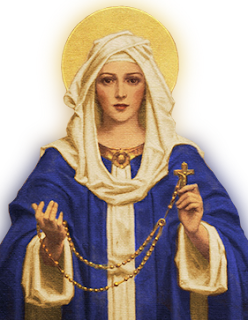Feast of Our Lady of the Rosary
O God, Whose only-begotten Son by His life, death and resurrection hath purchased for us the rewards of eternal salvation, grant we beseech Thee, that meditating on these mysteries of the most holy Rosary of the Blessed Virgin Mary, we may both imitate what they contain and obtain what they promise through Christ our Lord.
On October 7, the Church celebrates the memorial of our Lady of the Rosary. Originally known as "Our Lady of Victory," the feast recalls the Battle of Lepanto, a 16th century naval action in which Christian forces (the Holy League) repelled a massive Turkish invasion. Pope Saint Pius V attributed the victory to the divine intervention of the Blessed Virgin Mary after urging Europe's Christians to pray the rosary for our Lady's intercession. Some accounts contend St. Pius V was granted a miraculous vision of the Holy League's victory. In 1573, St. Pius V established the feast. Clement XI extended it to the universal Church in 1716.History of the RosaryAccording to tradition, in the 12th century, the rosary was given to Saint Dominic by Mary herself. But the devotion spread by Dominic did not resemble the rosary we pray today. Originally, the rosary had 150 beads, representing the number of psalms in the Bible. Religious orders recited the 150 Psalms daily as a way to mark the hours. Those who did not know how to read could share in this practice, by praying on a string of 150 beads in lieu of praying the psalms. In this way, the illiterate could pay homage to Jesus and the Blessed Mother throughout the day.The first rosary entailed reciting the "Our Father" over each bead. The "Hail Mary" as we know it, did not exist at the time. That Marian prayer owes its origin to the rosary. Shortly after its introduction, when people prayed the rosary, Gabrielle’s greeting, "Hail Mary, full of grace, the Lord is with thee", was often said along with the Our Father. Later, Elizabeth’s greeting, "blessed are you among women" was added. In the 16th century, the words, "Holy Mary, Mother of God, pray for us sinners now and at the hour of our death", were included.Dominic of Prussia, a 15th century Carthusian monk, divided the rosary into fifteen decades and assigned mysteries to each. The mysteries are events in the life of Christ from the Gospels. Dominic’s mysteries were like today’s except for the last two Glorious mysteries. The Coronation and the Assumption together comprised the fourteenth decade. The fifteenth decade was the Last Judgment.In 2002, Pope Saint John Paul II, added five new mysteries called the "Luminous Mysteries" or "Mysteries of Light" concerning the ministry of Christ. The rosary is the most efficacious prayer to the holy Mother of God invoking her intercession.

